Xiaoguang Han
MV-Performer: Taming Video Diffusion Model for Faithful and Synchronized Multi-view Performer Synthesis
Oct 08, 2025Abstract:Recent breakthroughs in video generation, powered by large-scale datasets and diffusion techniques, have shown that video diffusion models can function as implicit 4D novel view synthesizers. Nevertheless, current methods primarily concentrate on redirecting camera trajectory within the front view while struggling to generate 360-degree viewpoint changes. In this paper, we focus on human-centric subdomain and present MV-Performer, an innovative framework for creating synchronized novel view videos from monocular full-body captures. To achieve a 360-degree synthesis, we extensively leverage the MVHumanNet dataset and incorporate an informative condition signal. Specifically, we use the camera-dependent normal maps rendered from oriented partial point clouds, which effectively alleviate the ambiguity between seen and unseen observations. To maintain synchronization in the generated videos, we propose a multi-view human-centric video diffusion model that fuses information from the reference video, partial rendering, and different viewpoints. Additionally, we provide a robust inference procedure for in-the-wild video cases, which greatly mitigates the artifacts induced by imperfect monocular depth estimation. Extensive experiments on three datasets demonstrate our MV-Performer's state-of-the-art effectiveness and robustness, setting a strong model for human-centric 4D novel view synthesis.
PF-LHM: 3D Animatable Avatar Reconstruction from Pose-free Articulated Human Images
Jun 16, 2025Abstract:Reconstructing an animatable 3D human from casually captured images of an articulated subject without camera or human pose information is a practical yet challenging task due to view misalignment, occlusions, and the absence of structural priors. While optimization-based methods can produce high-fidelity results from monocular or multi-view videos, they require accurate pose estimation and slow iterative optimization, limiting scalability in unconstrained scenarios. Recent feed-forward approaches enable efficient single-image reconstruction but struggle to effectively leverage multiple input images to reduce ambiguity and improve reconstruction accuracy. To address these challenges, we propose PF-LHM, a large human reconstruction model that generates high-quality 3D avatars in seconds from one or multiple casually captured pose-free images. Our approach introduces an efficient Encoder-Decoder Point-Image Transformer architecture, which fuses hierarchical geometric point features and multi-view image features through multimodal attention. The fused features are decoded to recover detailed geometry and appearance, represented using 3D Gaussian splats. Extensive experiments on both real and synthetic datasets demonstrate that our method unifies single- and multi-image 3D human reconstruction, achieving high-fidelity and animatable 3D human avatars without requiring camera and human pose annotations. Code and models will be released to the public.
Hi3DGen: High-fidelity 3D Geometry Generation from Images via Normal Bridging
Mar 31, 2025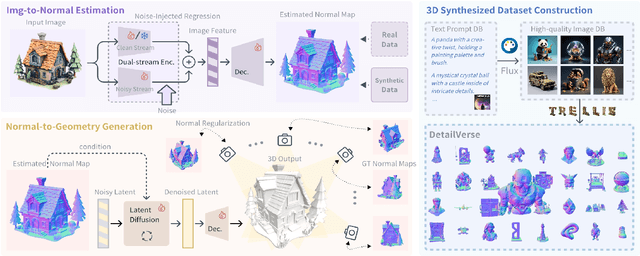
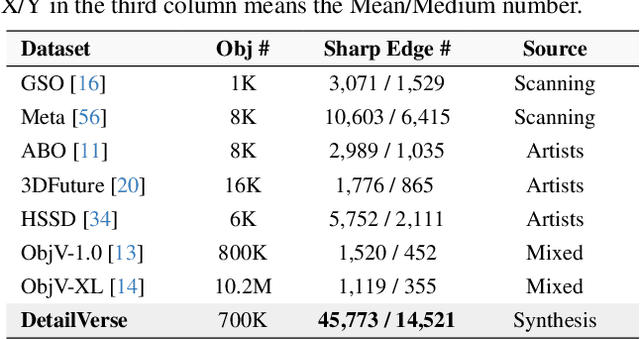
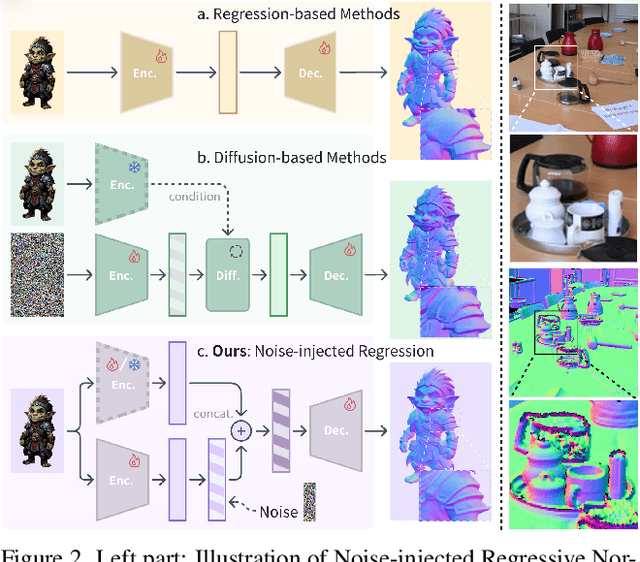
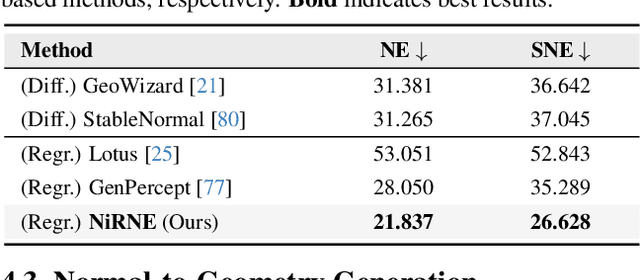
Abstract:With the growing demand for high-fidelity 3D models from 2D images, existing methods still face significant challenges in accurately reproducing fine-grained geometric details due to limitations in domain gaps and inherent ambiguities in RGB images. To address these issues, we propose Hi3DGen, a novel framework for generating high-fidelity 3D geometry from images via normal bridging. Hi3DGen consists of three key components: (1) an image-to-normal estimator that decouples the low-high frequency image pattern with noise injection and dual-stream training to achieve generalizable, stable, and sharp estimation; (2) a normal-to-geometry learning approach that uses normal-regularized latent diffusion learning to enhance 3D geometry generation fidelity; and (3) a 3D data synthesis pipeline that constructs a high-quality dataset to support training. Extensive experiments demonstrate the effectiveness and superiority of our framework in generating rich geometric details, outperforming state-of-the-art methods in terms of fidelity. Our work provides a new direction for high-fidelity 3D geometry generation from images by leveraging normal maps as an intermediate representation.
Stable-SCore: A Stable Registration-based Framework for 3D Shape Correspondence
Mar 27, 2025Abstract:Establishing character shape correspondence is a critical and fundamental task in computer vision and graphics, with diverse applications including re-topology, attribute transfer, and shape interpolation. Current dominant functional map methods, while effective in controlled scenarios, struggle in real situations with more complex challenges such as non-isometric shape discrepancies. In response, we revisit registration-for-correspondence methods and tap their potential for more stable shape correspondence estimation. To overcome their common issues including unstable deformations and the necessity for careful pre-alignment or high-quality initial 3D correspondences, we introduce Stable-SCore: A Stable Registration-based Framework for 3D Shape Correspondence. We first re-purpose a foundation model for 2D character correspondence that ensures reliable and stable 2D mappings. Crucially, we propose a novel Semantic Flow Guided Registration approach that leverages 2D correspondence to guide mesh deformations. Our framework significantly surpasses existing methods in challenging scenarios, and brings possibilities for a wide array of real applications, as demonstrated in our results.
Exploring Disentangled and Controllable Human Image Synthesis: From End-to-End to Stage-by-Stage
Mar 25, 2025



Abstract:Achieving fine-grained controllability in human image synthesis is a long-standing challenge in computer vision. Existing methods primarily focus on either facial synthesis or near-frontal body generation, with limited ability to simultaneously control key factors such as viewpoint, pose, clothing, and identity in a disentangled manner. In this paper, we introduce a new disentangled and controllable human synthesis task, which explicitly separates and manipulates these four factors within a unified framework. We first develop an end-to-end generative model trained on MVHumanNet for factor disentanglement. However, the domain gap between MVHumanNet and in-the-wild data produce unsatisfacotry results, motivating the exploration of virtual try-on (VTON) dataset as a potential solution. Through experiments, we observe that simply incorporating the VTON dataset as additional data to train the end-to-end model degrades performance, primarily due to the inconsistency in data forms between the two datasets, which disrupts the disentanglement process. To better leverage both datasets, we propose a stage-by-stage framework that decomposes human image generation into three sequential steps: clothed A-pose generation, back-view synthesis, and pose and view control. This structured pipeline enables better dataset utilization at different stages, significantly improving controllability and generalization, especially for in-the-wild scenarios. Extensive experiments demonstrate that our stage-by-stage approach outperforms end-to-end models in both visual fidelity and disentanglement quality, offering a scalable solution for real-world tasks. Additional demos are available on the project page: https://taited.github.io/discohuman-project/.
TASTE-Rob: Advancing Video Generation of Task-Oriented Hand-Object Interaction for Generalizable Robotic Manipulation
Mar 14, 2025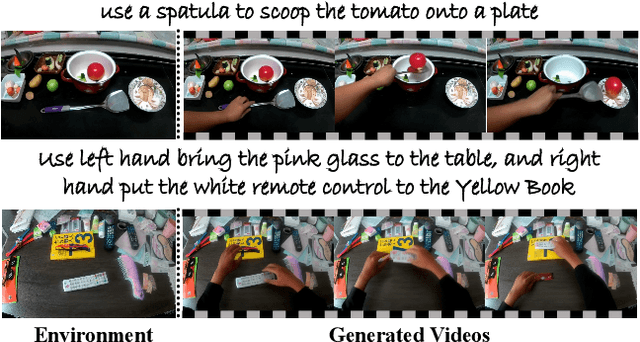



Abstract:We address key limitations in existing datasets and models for task-oriented hand-object interaction video generation, a critical approach of generating video demonstrations for robotic imitation learning. Current datasets, such as Ego4D, often suffer from inconsistent view perspectives and misaligned interactions, leading to reduced video quality and limiting their applicability for precise imitation learning tasks. Towards this end, we introduce TASTE-Rob -- a pioneering large-scale dataset of 100,856 ego-centric hand-object interaction videos. Each video is meticulously aligned with language instructions and recorded from a consistent camera viewpoint to ensure interaction clarity. By fine-tuning a Video Diffusion Model (VDM) on TASTE-Rob, we achieve realistic object interactions, though we observed occasional inconsistencies in hand grasping postures. To enhance realism, we introduce a three-stage pose-refinement pipeline that improves hand posture accuracy in generated videos. Our curated dataset, coupled with the specialized pose-refinement framework, provides notable performance gains in generating high-quality, task-oriented hand-object interaction videos, resulting in achieving superior generalizable robotic manipulation. The TASTE-Rob dataset will be made publicly available upon publication to foster further advancements in the field.
BAG: Body-Aligned 3D Wearable Asset Generation
Jan 27, 2025



Abstract:While recent advancements have shown remarkable progress in general 3D shape generation models, the challenge of leveraging these approaches to automatically generate wearable 3D assets remains unexplored. To this end, we present BAG, a Body-aligned Asset Generation method to output 3D wearable asset that can be automatically dressed on given 3D human bodies. This is achived by controlling the 3D generation process using human body shape and pose information. Specifically, we first build a general single-image to consistent multiview image diffusion model, and train it on the large Objaverse dataset to achieve diversity and generalizability. Then we train a Controlnet to guide the multiview generator to produce body-aligned multiview images. The control signal utilizes the multiview 2D projections of the target human body, where pixel values represent the XYZ coordinates of the body surface in a canonical space. The body-conditioned multiview diffusion generates body-aligned multiview images, which are then fed into a native 3D diffusion model to produce the 3D shape of the asset. Finally, by recovering the similarity transformation using multiview silhouette supervision and addressing asset-body penetration with physics simulators, the 3D asset can be accurately fitted onto the target human body. Experimental results demonstrate significant advantages over existing methods in terms of image prompt-following capability, shape diversity, and shape quality. Our project page is available at https://bag-3d.github.io/.
1-2-1: Renaissance of Single-Network Paradigm for Virtual Try-On
Jan 09, 2025



Abstract:Virtual Try-On (VTON) has become a crucial tool in ecommerce, enabling the realistic simulation of garments on individuals while preserving their original appearance and pose. Early VTON methods relied on single generative networks, but challenges remain in preserving fine-grained garment details due to limitations in feature extraction and fusion. To address these issues, recent approaches have adopted a dual-network paradigm, incorporating a complementary "ReferenceNet" to enhance garment feature extraction and fusion. While effective, this dual-network approach introduces significant computational overhead, limiting its scalability for high-resolution and long-duration image/video VTON applications. In this paper, we challenge the dual-network paradigm by proposing a novel single-network VTON method that overcomes the limitations of existing techniques. Our method, namely MNVTON, introduces a Modality-specific Normalization strategy that separately processes text, image and video inputs, enabling them to share the same attention layers in a VTON network. Extensive experimental results demonstrate the effectiveness of our approach, showing that it consistently achieves higher-quality, more detailed results for both image and video VTON tasks. Our results suggest that the single-network paradigm can rival the performance of dualnetwork approaches, offering a more efficient alternative for high-quality, scalable VTON applications.
MCMat: Multiview-Consistent and Physically Accurate PBR Material Generation
Dec 18, 2024



Abstract:Existing 2D methods utilize UNet-based diffusion models to generate multi-view physically-based rendering (PBR) maps but struggle with multi-view inconsistency, while some 3D methods directly generate UV maps, encountering generalization issues due to the limited 3D data. To address these problems, we propose a two-stage approach, including multi-view generation and UV materials refinement. In the generation stage, we adopt a Diffusion Transformer (DiT) model to generate PBR materials, where both the specially designed multi-branch DiT and reference-based DiT blocks adopt a global attention mechanism to promote feature interaction and fusion between different views, thereby improving multi-view consistency. In addition, we adopt a PBR-based diffusion loss to ensure that the generated materials align with realistic physical principles. In the refinement stage, we propose a material-refined DiT that performs inpainting in empty areas and enhances details in UV space. Except for the normal condition, this refinement also takes the material map from the generation stage as an additional condition to reduce the learning difficulty and improve generalization. Extensive experiments show that our method achieves state-of-the-art performance in texturing 3D objects with PBR materials and provides significant advantages for graphics relighting applications. Project Page: https://lingtengqiu.github.io/2024/MCMat/
MVImgNet2.0: A Larger-scale Dataset of Multi-view Images
Dec 02, 2024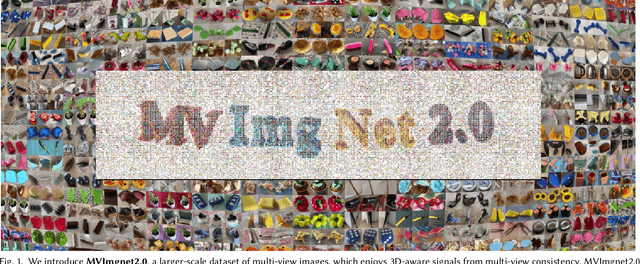
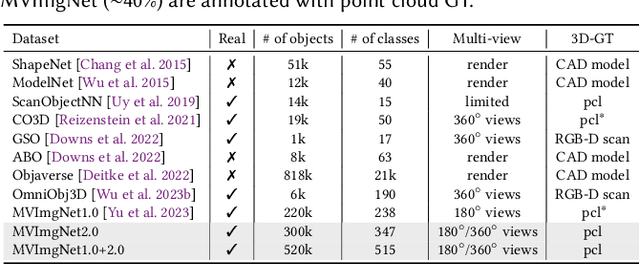
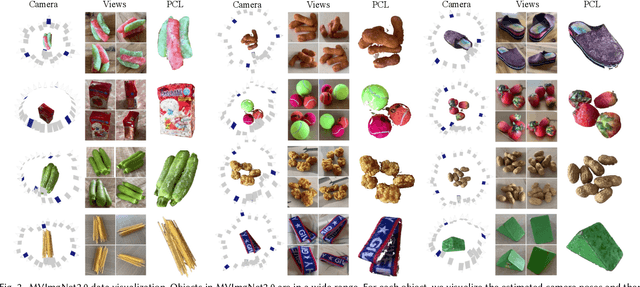
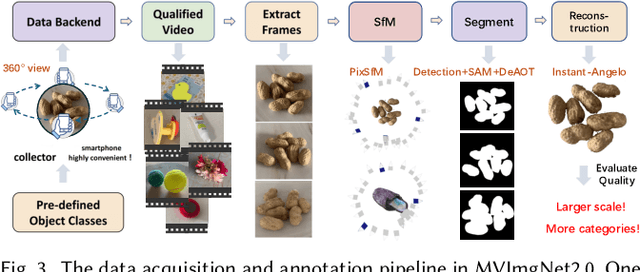
Abstract:MVImgNet is a large-scale dataset that contains multi-view images of ~220k real-world objects in 238 classes. As a counterpart of ImageNet, it introduces 3D visual signals via multi-view shooting, making a soft bridge between 2D and 3D vision. This paper constructs the MVImgNet2.0 dataset that expands MVImgNet into a total of ~520k objects and 515 categories, which derives a 3D dataset with a larger scale that is more comparable to ones in the 2D domain. In addition to the expanded dataset scale and category range, MVImgNet2.0 is of a higher quality than MVImgNet owing to four new features: (i) most shoots capture 360-degree views of the objects, which can support the learning of object reconstruction with completeness; (ii) the segmentation manner is advanced to produce foreground object masks of higher accuracy; (iii) a more powerful structure-from-motion method is adopted to derive the camera pose for each frame of a lower estimation error; (iv) higher-quality dense point clouds are reconstructed via advanced methods for objects captured in 360-degree views, which can serve for downstream applications. Extensive experiments confirm the value of the proposed MVImgNet2.0 in boosting the performance of large 3D reconstruction models. MVImgNet2.0 will be public at luyues.github.io/mvimgnet2, including multi-view images of all 520k objects, the reconstructed high-quality point clouds, and data annotation codes, hoping to inspire the broader vision community.
* ACM Transactions on Graphics (TOG), SIGGRAPH Asia 2024
 Add to Chrome
Add to Chrome Add to Firefox
Add to Firefox Add to Edge
Add to Edge